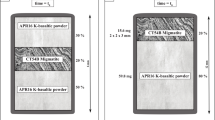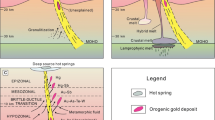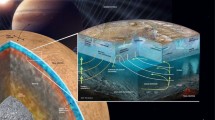Abstract
Between December 1998 and April 2001, a submarine basaltic eruption occurred west of Terceira Island, Azores (Portugal) in water depths between 300 and 1,000 m. Physical evidence for the eruption was provided by the periodic occurrence of hot lava “balloons” floating on the sea surface. The balloons consisted of a large gas-filled cavity surrounded by a thin shell (a few centimetres thick). The shells of the collected balloons are composed of two layers, termed the outer layer and the inner layer, defined by different bubble number density, bubble sizes and crystal content. The inner layer is further divided into three sublayers defined by more subtle differences in vesicularity. The outer layer is glassy, golden-coloured and highly porous. It shows signs of fluidal deformation and late-stage extension cracks. Interstitial glass contains 0.29 wt% H2O and CO2 is below detection. Melt inclusions contain up to 1.18 wt% H2O and 1,500 ppm CO2 (from different inclusions). Cooling rates of the outermost glass of the outer layer are found to be as high as 1,259 K/s. During ascent of low viscosity magma to the ocean floor, volatiles, dominated by CO2, exsolved from the magma (melt + crystals). The buoyancy of the vapour phase that accumulated below a thin crust on lava ponded at the vent caused bulging and ultimately cracking of the crust. This allowed large bubbles (central cavity) surrounded by a film of vesicular magma (balloon shell) to leak into the water column. On contact with the seawater, the outermost part of the outer layer of the shell hyperquenched. If an entirely closed shell was produced during detachment, the trapped gas inside allowed buoyant rise. Only balloons with the right balance of physical properties (e.g. size and bulk density) rose all the way to the sea surface.







Similar content being viewed by others
References
Beier C, Haase KM, Hansteen TH (2006) Magma evolution of the Sete Cidades Volcano, São Miguel, Azores. J Petrol 47:1375–1411
Beier C, Haase KM, Abouchami W, Krienitz MS, Hauff F (2008) Magma genesis by rifting of oceanic lithosphere above anomalous mantle: Terceira Rift, Azores. Geochem Geophys Geosys 9:Q12013. doi:10.1029/2008GC002112
Bézos A, Humler E (2005) The Fe3+/∑Fe ratios of MORB glasses and their implications for mantle melting. Geochim Cosmochim Acta 69:711–725
Clague DA, Paduan JB (2009) Submarine basaltic volcanism. In: Cousens B and Piercey SJ (eds) Submarine volcanism and mineralization: modern through ancient. Geological Association of Canada, Short Course 29–30 May 2008, Quebec City, Canada, pp. 41–60
Danyushevsky LV, Plechov P (2011) Petrolog3: integrated software for modelling crystallization processes. Geochem Geophys Geosys 12:Q07021. doi:10.1029/2011GC003516
Dixon JE, Stolper E, Delaney JR (1988) Infrared spectroscopic measurements of CO2 and H2O in Juan de Fuca Ridge basaltic glasses. Earth Planet Sci Lett 90:87–104
Fine G, Stolper E (1986) Dissolved carbon dioxide in basaltic glasses: concentration and speciation. Earth Planet Sci Lett 76:263–278
Gaspar JL, Queiroz G, Pacheco JM, Ferreira T, Wallenstein N (2003) Basaltic lava balloons produced during the 1998–2001 Serreta Submarine Ridge eruption (Azores). In: White J, Clague D, Smellie J (eds) Subaqueous explosive volcanism. AGU Monograph 140:205–212
Giordano D, Russell JK, Dingwell DB (2008) Viscosity of magmatic liquids: a model. Earth Planet Sci Lett 271:123–134
Guo X, Potuzak M, Mauro JC, Allan DC, Kiczenski TC, Yue Y (2011) Unified approach for determining the enthalpic fictive temperature of glasses with arbitrary thermal history. J Non-Cryst Sol 357:3230–3236
Lange RA, Carmichael ISE (1987) Densities of Na2O-K2O-CaO-MgO-FeO-Fe2O3-Al2O3-TiO2-SiO2 liquids: New measurements and derived partial molar properties. Geochim Cosmochim Acta 51: 2931–2946
Le Bas MJ, Le Maitre RW, Streckeisen A, Zanettin B (1986) A chemical classification of volcanic rocks based on the total alkali–silica diagram. J Petrol 27:745–750
Macdonald GA (1968) Composition and origin of Hawaiian lavas. Geol Soc Am Mem 116:477–522
Mattioli M, Upton BGJ, Renzulli A (1997) Sub-volcanic crystallization at Sete Cidades volcano, São Miguel, Azores, inferred from mafic and ultramafic plutonic nodules. Mineral Petrolog 60(1–2):1–26
Michael PJ, Cornell WC (1998) Influence of spreading rate and magma supply on crystallisation and assimilation beneath mid-ocean ridges: Evidence from chlorine and major element chemistry of mid-ocean ridge basalts. J Geophys Res 103:18325–18356
Moore JG, Fornari DJ, Clague DA (1985) Basalts from the 1877 submarine eruption of Mauna Loa, Hawaii: New data on the variation of the palagonization rate with temperature. US Geol Surv Bull 1663
Newman S, Lowenstern JB (2002) VolatileCalc: a silicate melt-H2O-CO2 solution model written in Visual Basic for excel. Comput Geosci 28:597–604
Nichols ARL, Wysoczanski RJ (2007) Using micro-FTIR spectroscopy to measure volatile contents in small and unexposed inclusions hosted in olivine crystals. Chem Geol 242:371–384
Nichols ARL, Potuzak M, Dingwell DB (2009) Cooling rates of basaltic hyaloclastites and pillow lava glasses from the HSDP2 drill core. Geochim Cosmochim Acta 73:1052–1066
Potuzak M, Nichols ARL, Dingwell DB, Clague DA (2008) Hyperquenched volcanic glass from Loihi Seamount, Hawaii. Earth Planet Sci Lett 270:54–62
Putirka KD (2005) Igneous thermometers and barometers based on plagioclase + liquid equilibria: tests of some existing models and new calibrations. Am Min 90:336–346
Renzulli A, Santi P (2000) Two-stage fractionation history of the alkali basalt-trachyte series of Sete Cidades volcano (São Miguel Island, Azores). Eur J Mineral 12:469–494
Riccò A (1892) Terremoti, sollevamento ed eruzione sottomarina a Pantelleria nella seconda metà dell’ottobre 1891. Annali Ufficio Centrale Meteorologico e Geodinamico 2: vol. XIV
Self S, Gunn BM (1976) Petrology, volume, and age relations of alkaline and saturated peralkaline volcanics from Terceira, Azores. Contrib Mineral Petrol 54:293–313
Siebe C, Komorowski JC, Navarro C, McHone J, Delgado H, Cortes A (1995) Submarine eruption near Socorro Island, México: geochemistry and scanning electron microscopy studies of floating scoria and reticulite. J Volcanol Geotherm Res 68:239–271
Stolper E (1982) Water in silicate glasses: an infrared spectroscopic study. Contrib Mineral Petrol 81:1–17
Troll VR, Klügel A, Longpré MA, Burchardt S, Deegan FM, Carracedo JC, Wiesmaier S, Kueppers U, Dahren B, Blythe LS, Hansteen TH, Freda C, Budd DA, Jolis EM, Jonsson E, Meade FC, Harris C, Berg SE, Mancini L, Polacci M, Pedroza K (2012) Floating stones off El Hierro, Canary Islands: xenoliths of pre-island sedimentary origin in the early products of the October 2011 eruption. Solid Earth 3:97–110, http://www.solid-earth.net/3/97/2012/se-3-97-2012.html
Ulmer P (1989) The dependence of the Fe2+-Mg cation-partitioning between olivine and basaltic liquid on pressure, temperature and composition: an experimental study to 30 kbars. Contrib Mineral Petrol 101:261–273
Vogt PR, Jung WY (2004) The Terceira rift as hyper-slow, hotspot-dominated oblique spreading axis: a comparison with other slow-spreading plate boundaries. Earth Planet Sci Lett 218:77–90
Weston FS (1964) List of recorded volcanic eruptions in the Azores with brief reports. Bol Mus Lab Miner 10:3–18
Wilding M, Dingwell D, Batiza R, Wilson L (2000) Cooling rates of hyaloclastites: applications of relaxation geospeedometry to undersea volcanic deposits. Bull Volcanol 61:527–536
Wysoczanski RJ, Tani K (2006) Spectroscopic FTIR imaging of water species in silicic volcanic glasses and melt inclusions: an example from the Izu-Bonin arc. J Volcanol Geotherm Res 156:302–314
Links to internet pages (in order of appearance)
http://www.ign.es/ign/resources/volcanologia/Galeria_Fotos/GaleriaFotos.html. Accessed on 28 Jan 2012
http://oceanexplorer.noaa.gov/explorations/06fire/logs/may4/may4.html. Accessed on 28 Jan 2012
http://oceanexplorer.noaa.gov/explorations/09laubasin/. Accessed on 28 Jan 2012
Acknowledgments
The authors would like to thank Rui Coutinho (CVARG) for his swift actions that guaranteed sampling during the first phase of the eruption in 1999, Pedro Cerqueira (CVARG) for assistance during sample description and documentation and Catarina Pereira (CVARG) for preparing Fig. 1b. Further thanks are due to Bill Chadwick (OSU), Dave Clague (MBARI) and Nick Deardorff (University of Oregon) for providing high-definition video footage and photographs of submarine eruptions and eruption sites. We also thank Frank Trusdell (HVO) and Marilena Calarco (INGV) for information on the eruptions in Kealakekua Bay and Pantelleria, respectively. In addition, Adriano Pimentel (CVARG) is acknowledged for sharing observations made during the 2008 oceanographic survey on the Serreta Ridge and Ed Llewellin (Durham University) for the insights he gave on field experiments in Hawai’i. We thank Claus Siebe and an anonymous referee for their thorough reviews that helped to improve this manuscript. We are indebted to the editor-in-charge, Jocelyn McPhie, for her detailed comments on the revised manuscript.
Author information
Authors and Affiliations
Corresponding author
Additional information
Editorial responsibility: J. McPhie
Appendices
Appendix 1
Whole-rock geochemistry
Rock powders were mixed with a flux of lithium metaborate and lithium tetraborate and fused in an induction furnace. The molten melt was poured into a solution of 5 % nitric acid containing an internal standard, and mixed continuously until completely dissolved (~30 min). The samples were analysed to determine major element compositions by ICP-MS at Activation Laboratories Ltd., Ontario (Canada). The relative standard deviation for major elements was less than 5 %. Three blanks and five controls were analysed per group of samples. Duplicates were fused and analysed every 15 samples. The instrument was recalibrated after 40 samples. Calibration was performed using BHVO, BR, GH and DRN international rock standards. Analytical precision (2σ) for major elements was about 1 %.
Appendix 2
Electron microprobe analysis
Glass, crystal phases, silicate melt inclusions (SMI) and their host crystals were analysed for major elements, plus S and Cl, by electron microprobe on a JEOL JXA-8800 Superprobe at the Institute for Research on Earth Evolution (IFREE), Japan Agency for Marine Earth Science and Technology (JAMSTEC). An accelerating voltage of 15 kV, a 15 nA beam current, a defocused 3 μm spot size and ZAF correction procedures were used. Na and K were analysed first on their respective spectrometers for 10 s on the peak and 5 s on the background. Peak and background analysis times for Si, Ti, Al, Fe, Mg and Ca were 20 and 10 s; for Mn, Ni, Cr, P were 30 and 10 s; for S were 50 and 25 s’ while for Cl, they were 240 and 120 s, respectively. Calibrations and spectrometer drift during measurements were checked by interspersing measurements on the secondary standards VG-2 glass, Saint John’s Island olivine, and scapolite amongst the sample measurements. To check for homogeneity at least 11 analyses were collected on the glass, at least three on selected crystals within the glassy samples, at least five on the SMI and at least six on the host crystal.
Appendix 3
FTIR spectroscopy
H2O and CO2 contents were determined by FTIR spectroscopy using a Varian FTS Stingray 700 Micro Image Analyser spectrometer at IFREE, JAMSTEC following the techniques of Nichols and Wysoczanski (2007). A UMA 600 microscope, attached to the spectrometer bench, was used to focus the beam on the area of interest. For the glass and fine particle spectra were collected over 512 scans with a beam size of 30 × 30 μm square, for the silicate melt inclusions (SMI) 1024 scans were collected mostly with a beam size of 20 × 20 μm, but some measurements were conducted at 15 × 15, 25 × 25 and 25 × 15 μm. On each glass sample, at least five spots were analysed; while on the fine particle, three spots were analysed to check for homogeneity while SMI were analysed from both sides. The concentrations of volatile species were calculated using the Beer–Lambert law (Stolper 1982). Peak heights (absorbance) above a linear baseline on spectra collected in transmitted light were used to calculate volatile concentrations. To determine total H2O, the peak at ~3,500 cm−1, caused by the O–H fundamental stretching vibration, was used with a molar absorptivity coefficient of 63 ± 5 l/mol cm (Dixon et al. 1988). CO2 concentrations were calculated from the average height of the peaks at ~1,515 and ~1,435 cm−1, caused by the asymmetric stretch of CO 2−3 groups, with a molar absorptivity coefficient of 375 ± 20 l/mol cm (Fine and Stolper 1986). The bulk densities of glass, ash and SMI were calculated on the basis of their major element composition using the model of Lange and Carmichael (1987). Wafer thickness was determined using the frequency of interference fringes on spectra taken in reflected light through exactly the same area as was analysed in transmitted light. The SMI hosted in clinopyroxene was prepared so that it was exposed on both sides and thus the thickness of the inclusion equals the wafer thickness. However, some of the olivine-hosted SMI were prepared so that only one surface was exposed. In this case, the method described in Nichols and Wysoczanski (2007) was followed to obtain inclusion thickness.
Spectroscopic images of areas 350 × 350 μm were measured to compare the volatiles contained within the SMI with those in glass attached to the outside of the same crystal. The images were collected using a Varian Inc. Lancer focal plane array (FPA) camera attached to the UMA 600 microscope, set up to collect images across the mid-IR spectral region, 6,000–400 cm−1. For more detailed discussions on imaging and the Lancer FPA camera, see Wysoczanski and Tani (2006) and Nichols and Wysoczanski (2007). For those SMI imaged, four spectra across the inclusion were used to add to the data collected by spot analysis and check for volatile homogeneity in the inclusion. The procedures to calculate the volatile data from these spectra are the same as those outlined above for the spot analysis.
Appendix 4
Differential scanning calorimetry
The structure of glass is mostly compositionally dependant and a careful characterization of its properties reveals the P-T-t conditions at which it formed. The variation of specific heat capacity (c p ) with temperature was measured using a differential scanning calorimeter (DSC Netzsch® 404C at Corning Inc.). The c p –curve, reflecting the natural cooling rate, was recorded during the first heating scan at 10 K min−1. Subsequent repeated cooling and heating treatments, performed on the same sample, allowed further c p –curves to be measured at known P-T-t conditions. A mathematical evaluation of the differences between the shape of the “natural” c p –curve and those measured under known experimental conditions, allows the natural cooling rate across the glass transition region to be quantified. A detailed description of the measurement procedure and calibration, as well as the accuracy of the technique, can be found in Potuzak et al. (2008) and Guo et al. (2011).
Rights and permissions
About this article
Cite this article
Kueppers, U., Nichols, A.R.L., Zanon, V. et al. Lava balloons—peculiar products of basaltic submarine eruptions. Bull Volcanol 74, 1379–1393 (2012). https://doi.org/10.1007/s00445-012-0597-x
Received:
Accepted:
Published:
Issue Date:
DOI: https://doi.org/10.1007/s00445-012-0597-x




